Common names of Japanese Knotweed include fleece flower, Himalayan fleece vine, silly weed, monkey weed, monkey fungus, Elephant ears, pea shooters, donkey rhubarb, American bamboo, and Mexican bamboo, among many others, depending on country and location.
Identifying Japanese knotweed
Japanese knotweed is a member of the buckwheat family. It prefers sunny, moist areas, including riverbanks, roadsides, lawns, and gardens. The plant arrived from japan to the U.K. and then to North America in the 19th century as a landscaping ornamental.
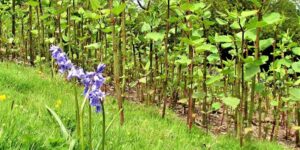
Japanese knotweed flowers are valued by some beekeepers as an important source of nectar for honeybees, at a time of year when little else is flowering. Japanese knotweed yields a monofloral honey, usually called bamboo honey by northeastern U.S. beekeepers, like a mild-flavoured version of buckwheat honey (a related plant also in the part Polygonaceae).
The young stems are edible as a spring vegetable, with a flavour similar to rhubarb. In some locations. I have used semi cultivating Japanese knotweed for food as a means of controlling knotweed populations that invade sensitive wetland areas and drive out the native vegetation. It is eaten in Japan as sensei or wild foraged vegetable.
It is used in traditional Chinese medicine to treat various disorders through the actions of resveratrol, although there is no high-quality evidence from clinical research for any medical efficacy.
How dangerous is Japanese Knotweed?
Despite causing damage to property, Japanese Knotweed is not harmful to humans, although some have reported that contact with the plant can cause some mild skin irritation. Japanese Knotweed is often confused with giant Hogweed, which does pose a real threat to people.
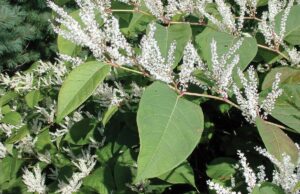
Is Japanese Knotweed good for anything?
Not only is it edible; it is good for you. Japanese Knotweed is an excellent source of vitamins A and C snd contains potassium, zinc, phosphorus and manganese. It has been used for centuries in its native countries for treating many ailments, such as respiratory infections.
Japanese Knotweed: Edible, medicinal, invasive
Japanese Knotweed (Reynoutria Japonica, Falloppia Japonica or Polygonum cuspidate) was originally introduced to the united states as an ornamental plant in the late 1800s and is now found in (at least) 39 states over a wide range of sites. Although considered extremely invasive, this plant, however, has edible shoots in spring and roots that have been found to have medicinal value.
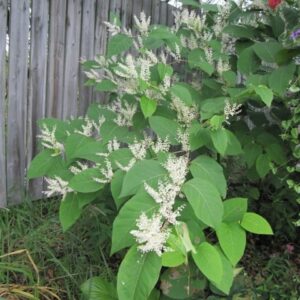
Japanese knotweed is an upright, herbaceous, perennial plant with hollow, red speckled bamboo-like stems that can grow over 10 feet tall when mature. It spreads by its roots or rhizomes, and pieces of this plant can root themselves if cut and discarded. Knotweed’s broad green leaves grow to be roughly 6 inches long and 4 inches wide.
Knotweed tolerated a wide variety of soils and growing conditions from sun to shade, but it grows especially well in moist areas with plenty of suns. It is very hardy, difficult to remove, and tends to take over when introduced. Early spring shoots and leaves are edible and have been described as a cross between asparagus and rhubarb.
Why is Japanese knotweed a problem?
Aquatic quality and flood risk- Aquatic organisms are less able to process knotweed leaf litter compared with the native vegetation it displaces and this has the potential to alter food chains. Dense summer foliage causes heavy shading of small streams, which reduces aquatic plant communities.
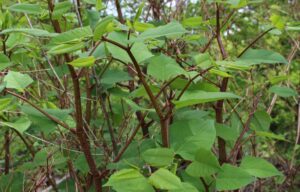
Some species such as dwarf Japanese knotweed can have pink flowers but these are less invasive and their incidence in the UK is lower. The Japanese knotweed we find in our gardens and on business properties have small clusters of flower that are creamy white.
They appear towards the end of the summer and into autumn, just before the plant becomes dormant and ‘closes down’ for the winter.
The Japanese knotweed is a highly invasive, fast-growing plant and it can cause significant structural damage which is why it is so important to get rid of quickly. It causes damage, however, by taking advantage of structural weaknesses such as cracks and gaps.
No plant can actually get through solid concrete but it will seek our cracks to try to eventually breakthrough. when the plant starts to grow more, it can shatter the surrounding concrete and cause more damage. If you have an area of concrete and is intact with no cracks and fissures, you should expect it to stay clear of Japanese knotweed.
Conclusion
Japanese knotweed is really a useful medicine whose native habitat is in Asia. It is seriously invasive here in North America and elsewhere. As a medicinal herb, however, It is unparalleled in what it can do and in the diversity of its actions.
Japanese knotweed is also having anti-cancer properties and is used extensively in China for the treatment and prevention of many types of cancer. It stimulates the immune system and the production of white blood cells. It is very useful in protocols addressing acute and chronic leukopenia, meaning low white blood cell count, whether due to sickness, cancer, radiation therapy or old age.
Japanese also crosses the blood-brain barrier, making it very useful as an antioxidant and anti-inflammatory agent for protecting and maintaining the heath of the brain. It also acts as a courier for other herbs, helping these medicines to also cross the blood-brain barrier.
Table of Contents





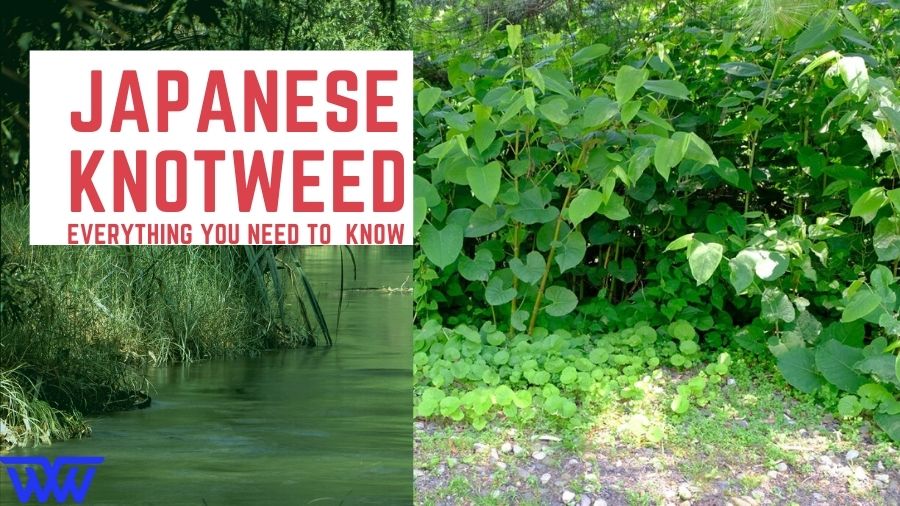

Add Comment